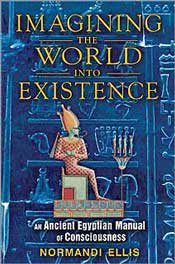 |
||
The Use of Healing Talismans and Amulets, excerpted from Imagining the World Into Existenceby Normandi Ellis
Outside the temple, the healer used many of the same healing techniques that a priest of Heka used inside the temple. This included the use of amulets and incantations—what modern people might think of these days as affirmations. Says the Ebers Papyrus, "Magic is effective together with medicine. Medicine is effective together with magic." This strongly suggests that true healing is a state of mind. As Mary Baker Eddy, the mother of Christian Science religion, suggests, "All is infinite mind and its infinite manifestation, for God is All-in-all. Spirit is immortal Truth…" Egyptologist Geraldine Pinch rightly surmised that magic gave the mind something concrete to attend to as one struggled with an illness. "Modern medicine is coming to realize that the mental and emotional state of the patient has much more effect on their physical condition than was originally allowed for the scientific model of disease. Egyptian medicine never neglected these aspects." One reason that amulets work is that they are culturally agreed-upon symbols. They offer an aggregate of group thought that intensifies the power of the icon. While ancient Egyptians may have had more than three thousand years of common understanding of their particular symbolic images, most First World citizens in the modern era have two thousand years or more of understanding of Christian iconography. Historically, symbols are built upon symbols, taking on some of the cultural patina that preceded them. Thus, it would not be surprising to find that the protective Christian symbol of the cross hanging above one's bed is related to the protective and similarly shaped ankh, the life-giving symbol linked with Isis. One may be anointed in the healing waters of Lourdes, France, or the healing waters of the Nile; both are said to flow from the throne of heaven. Far from feeling perplexed by the similarity of pagan and Christian references, we ought to feel invigorated that the language in which the Divine spoke with the ancients is just as alive and vibrant in our age as it was in theirs. A Catholic supplicant might request a healing through the auspices of the Blessed Virgin Mary, or the Lady of the Miraculous Medal, or Our Lady of Guadalupe. Egyptian healers sought the help of Isis, who was great of magic, and often began their incantations by saying, "May I be granted the words of power of Isis." Some charms literally get under our skin. Sacred drama is one way of empowering us through a deeper understanding of spiritual principles. A Catholic or Protestant walking the Stations of the Cross during Lent takes on either the role of Christ who suffered or the crowd who betrayed him in the court of Pontius Pilate. On festival days, ancient Egyptians reenacted the sacred dramas of the death of Osiris, the mortal battle between Horus and Seth, and the birth of the Holy Child. In the confined space of a temple or in the home of the client, the magician often called on the powers of gods and goddesses, going so far as to embody the divine healer. In sacred healing rituals, the priest or priestess became an empty vessel through which the voice spoke and the hands of the god or goddess worked. Through the power of the "true voice" of the god, the healer commanded evil to leave and the patient to thrive. These practices resemble Christian ideas about exorcism through amulet, prayer, and faith. Psychodrama is a cultural shamanic technique used throughout the world from prehistory to the modern era. African traditions allow a healer to contact and work with ancestral spirits. While modern "family constellation therapy" developed by German psychotherapist Bert Hellinger has a less religious agenda, its effects are as deeply and powerfully felt as a shamanic journey. In this case, an individual "stands in" for the client's living or dead family members and allows the healing drama of those family members during a particular life event. Becoming empty vessels, the participants in the constellation allow a family story to be told through them for the benefit of another's healing and understanding. -Normandi Ellis Imagining the World Into Existence, with other books by Normandi Ellis, are available on Hathor's Mirror |
||

